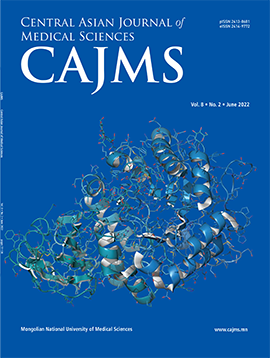The Effect of Astragalus Mongholicus Bunge Extract on Isoproterenol-Induced Myocardial Infarction in Rats
DOI:
https://doi.org/10.24079/cajms.2020.09.003Keywords:
Myocardial Infarction, Astragalus Mongholicus Bunge, Isoproterenol, Cardiovascular DiseasesAbstract
Objectives: Our study’s objective was to investigate the cardioprotective effects of Astragalus mongholicus Bunge, a herbal medicine cultivated in Mongolia. Methods: Fifty rats were divided into five groups of ten. The untreated control and treatment group rats received isoproterenol (150 mg/kg) by subcutaneous injection for two consecutive days on 29th and 30th days to induce myocardial infarction. The treatment groups received Astragalus mongholicus Bunge 71, 142, or 284 mg/kg for 28 days prior to infarction. At the end of the experiment, Astragalus mongholicus Bunge’s cardioprotective effect was assessed through histopathology, the measurement of serum CK, AST, ALT, and LDH, and the oxidative stress markers malondialdehyde and total superoxide dismutase. Results: Treatment with Astragalus mongholicus Bunge 71 mg/kg caused significant decreases in the levels of LDH, AST, and CK serum compared with the control group (p < 0.05). Treatment with Astragalus mongholicus Bunge at 71, 142, and 284 mg/kg showed a significant decrease in malondialdehyde compared with the control group (p < 0.05). Treatment with Astragalus mongholicus Bunge at the same levels significantly reduced myocardial damage by protecting levels of the beneficial antioxidant enzyme total superoxide dismutase (p < 0.05). Histopathological examination of the group treated with Astragalus mongholicus Bunge 142 mg/kg showed a decreased area with necrosis and inflammatory cells in the myocardial tissue. Conclusion: The protective effect of Astragalus mongholicus Bunge occurs by protecting the myocardium’s native superoxide dismutase levels, reducing the levels of malondialdehyde and serum marker enzymes LDH, AST, and CK.
Downloads
284
Downloads
Published
How to Cite
Issue
Section
License
Copyright (c) 2020 Mongolian National University of Medical Sciences

This work is licensed under a Creative Commons Attribution-NonCommercial 4.0 International License.




